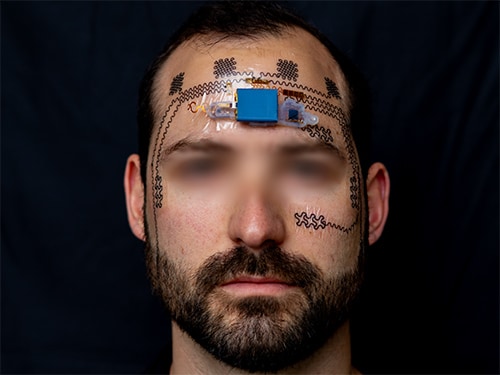Wireless Face e-Tattoo Tracks Mental Strain and Workload
A temporary electronic forehead tattoo that wirelessly measures brainwaves and eye movement may offer an accurate measurement of mental workload (MWL) and mental strain, new research suggested.

Using a lightweight battery and thin sensors, the e-tattoo was able to reliably collect electroencephalography (EEG) and electrooculography (EOG) data to estimate MWL in a small study of six participants as they completed increasingly difficult memory tests.
The technology is a less bulky and cheaper alternative to conventional brain activity monitors and may help track the mental workload of workers in safety-critical jobs like aviation, air traffic control, and healthcare. Researchers say it also has applications for neurological monitoring of patients with epilepsy or to monitor cognitive decline.
“Our wireless electronic tattoo stands out for its ultrathin, skin-conformal design, which allows for stable EEG/EOG signal acquisition even during dynamic activities like walking or facial movements,” investigator Nanshu Lu, PhD, professor and chair of engineering, The University of Texas at Austin, told Medscape Medical News. “Unlike other platforms like headbands or glasses, our tattoo is helmet-compatible, low-profile, and uses low-cost disposable materials, making it uniquely suitable for real-world deployment.”
The findings were published online on May 29 in the journal Device.
Study Details and Performance
There is no universally accepted definition of MWL, but it can generally be described as the degree to which a person’s working memory capacity and cognitive processes are engaged by an ongoing task, the authors noted.
MWL levels can be assessed using subjective self-assessment questionnaires like the post-task NASA Task Load Index, as well as physiological measures such as heart rate, galvanic skin response, EEG, and EOG.
The wireless e-tattoo features stretchable serpentine-shaped, graphite-deposited polyurethane electrodes coated with an adhesive poly(3,4-ethylenedioxythiophene) poly-styrene sulfonate composite to reduce impedance and improve adhesion to the skin. The e-tattoo is integrated with a battery-powered flexible printed circuit that transmits EEG and EOG data in real-time via Bluetooth Low Energy.
To evaluate the e-tattoo efficacy, the researchers analyzed EEG and EOG signals collected on six healthy participants wearing the wireless forehead e-tattoo during cognitive tasks designed to measure working memory, called dual N-back tasks. Self-assessment using the NASA–Task Load Index, task performance metrics, and physiological features were also collected.
Each participant completed a single experiment session lasting approximately 2.5 hours, which included three runs of N-back trials.
“This single-session design was sufficient to train individualized models, although variability between participants was observed, especially in the relative importance of EEG vs EGO features,” Lu said.
As the cognitive workload increased, frontal delta- and theta-band powers increased, while alpha-, beta-, and gamma-band powers decreased. The authors noted this is in line with studies linking theta-band power to an increase in working memory load and increasing MWL with a decrease in alpha power and increase in frontal theta power.
To test the viability of mental workload estimation using the e-tattoo, the researchers then built a random forest model to predict the level of mental workload experienced by participants during the N-back tasks. They found that the model successfully estimated the mental workload for all N levels for all six participants.
“Key findings of our study show that the wireless forehead e-tattoo reliably captures forehead EEG and EOG signals, and these signals can be used to accurately estimate mental workload during a dual N-back task, which is a widely used standard mental workload test,” Lu said. “Our model achieved robust classification of cognitive load levels using only minimally processed physiological data.”
The Road Ahead
For forehead EEG/EOG–driven workload detection, the e-tattoo system is already self-sufficient but integration with other physiological sensors such as heart rate or galvanic skin response could improve accuracy and robustness in mental workload vs mental stress differentiation, Lu noted.
“In medical settings, this technology could be very useful for neurological monitoring, including early detection of cognitive decline, noninvasive epilepsy tracking, and assessing patient engagement during neurorehabilitation,” she said. “Its comfort and unobtrusiveness make it especially appealing for pediatric or geriatric use.”
The temporary e-tattoo also holds a cost advantage over traditional EEG systems, with the e-tattoo chips and battery pack priced at $200 and disposable sensors about $20 each.
“Being low-cost makes the device accessible,” study co-author Luis Sentis, PhD, also from The University of Texas at Austin, said in a news release. “One of my wishes is to turn the e-tattoo into a product we can wear at home.”
Currently, the e-tattoo works only on hairless skin but the researchers are working to combine it with ink-based sensors that work on hair. For this new study, Lu also noted that EEG signals were postprocessed and the predictions done offline.
“To make this technology really valuable, we can and need to achieve real-time mental workload assessment and provide timely micro-interventions, such as visual or audio alerts on the phone or even electro tactile stimulations applied to the skin by the e-tattoo before performance decline or burnout occurs,” she said.
“Evaluating these micro-interventions in real-world applications may prove our EEG system’s capacity to significantly improve human-AI collaborations,” Sentis told Medscape Medical News.
Lu reported support from the US Army Research Office. The authors declared no competing interests.


 Admin_Adham
Admin_Adham


